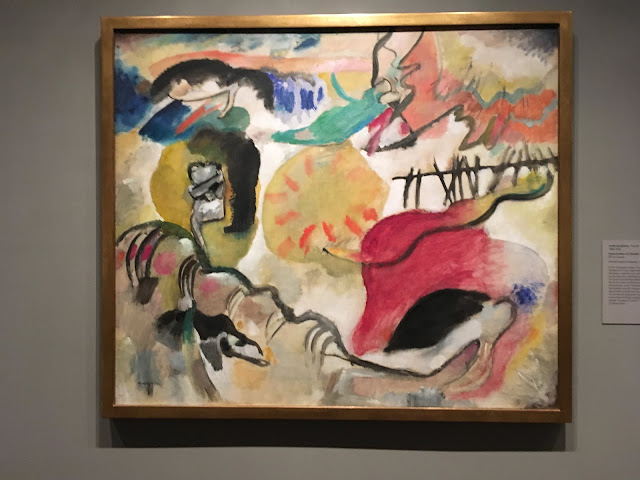I went on a marvelous trip to Maine and New York City, and on returning home got bogged down in art fairs and recitals and whatnot! Especially whatnot!
When in New York, I saw the Hilma af Klint show at the Guggenheim.
https://www.guggenheim.org/exhibition/hilma-af-klint
it is a MUST see!

Here is an introduction to af Klimt I wrote about 3 years ago:
Hilma Af Klint
While a number of male artists, for example Kandinsky, Braque and others, are generally regarded as the pioneers of abstract art, it is more likely that it was a woman who was the first abstract artist.
Kandinsky felt that he had painted his first abstract picture in 1911; he wrote about one of his paintings that it was “Indeed the world’s first ever abstract picture, no other painter was painting in an abstract style"..
Look at this detail with the effect of stitching!! Love it....
Various artists vied with each other as to who was the first: as well as Kandinksy, František Kupka, Robert Delaunay, Piet Mondrian and Kazimir Malevich were amongst the earliest abstract artists.
What Kandinsky and the others did not know is that a Swedish painter by the name of Hilma af Klint (1862-1944) had created her first abstract painting in her Stockholm studio in 1906, five years before his first abstract painting. Hilma af Kllnt was lucky enough to be born in Sweden, a country that allowed women to study art long before other European countries. She enrolled in the Royal Academy of Fine Arts in Stockholm in 1882 for a five year course of study, after which she rented a studio in the artist’s quarter of Stockholm and developed a reputation as an excellent landscape and portrait painter.
In the 19th century, few believed that women could be inspired by spiritual or philosophical matters but a Russian, Helena Blavatsky, was an occultist who co-founded a “religious” she called the Theosophical Society.
Read more about her here: https://en.wikipedia.org/wiki/Helena_Blavatsky
What is interesting is that unlike other such organizations, in the Theosophical Society women were allowed to hold senior positions and were considered equal to men – this idea, of course, was way ahead of its time. af Klint had joined this group even before she went to art school and attended her first spiritualist séance at age 17.

So Klint was in a place and time and with people who did not discriminate against women or limit them in any way. During the séances, she made drawings (automatic drawings) which were said to have been made unconsciously and in 1906 she began to paint a series of abstracts, small canvases called Primordial Chaos. Some look like seascapes with mysterious lights, others use geometric shapes like spirals, letters, and other symbols.
During a séance, Af Klint was told by a spirit guide that she had been ‘commissioned’ to make paintings “on the astral plane”. She said: ‘The pictures were painted directly through me, without any preliminary drawings and with great force. I had no idea what the paintings were supposed to depict”.
She worked in watercolor and gouache on large (3m) pieces of paper which she laid on the floor creating enormous, dazzlingly beautiful paintings. ‘The Ten Largest’ is a visual study of the four ages of man from a spiritual perspective.
Alas, none of her work was ever shown during her life and even today, few museums accept her as a great artist.
Thank goodness!! This is no longer true....
What led Klint to abstraction? People at that time had a great interest in invisible forces; there were many new scientific discoveries such as infrared light, X-rays and electromagnetic fields. These discoveries led artists to wonder if one could paint these phenomena. Could one paint abstract things like music?
There are groups of smaller paintings too in the Guggenheim show:
The show is a marvelous step forward in the recognition of women artists, but it is also a great inspiration for all of us, no matter what medium we work in.
Go and see it!!! It's up into the Spring.....
If you have been, thanks for reading!
Elizabeth
PS love comments!! So have at it folks!!!
Also write me: elizabethmasterclass AT gmail if you are interested in a master class next year - you can join for 3,6 or 12 months..specific assignments or independent study.

































































